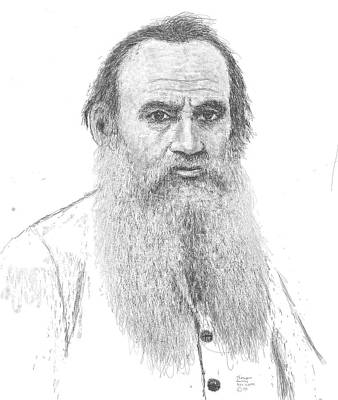Leo Tolstoy Archive
Written: 1888
Source: Translated by Nathan Haskell Dole
Transcription/Markup: Andy Carloff
Online Source: RevoltLib.com; 2021

One time I went out hunting with Milton. Just as we reached the forest he began to get a scent. He stretched out his tail, pricked up his ears, and began to sniff.
I got my musket ready and started after him. I sup- posed that he was on the track of a partridge, or a pheas- ant, or a hare. But Milton did not turn off into the woods, but into a field. I followed him and looked ahead.
Suddenly I caught sight of what he was after. In front of him a little turtle was making its way it was of the size of a hat. Its bald, dark gray head and long neck were thrust out like a pistil. The turtle was mov- ing along by the aid of its bare feet, and its back was wholly covered by its shell.
As soon as it saw the dog, it drew in its legs and head and flattened itself down into the grass, so that only its shell was visible.
Milton grabbed it and tried to bite it ; but he could not set his teeth through it, because the turtle has over its belly the same sort of crust as over its back, with mere openings in front, on the side, and at the back for putting out its head, legs, and tail.
I rescued the turtle from Milton, and examined how its back was marked, and how its shell was constructed, and how it managed to hide itself away. When you hold one in your hands and look under the shell, then, only, can you see something within, black and living.
I laid the turtle down on the grass and went on, but Milton was loathe to leave it ; he seized it in his teeth and followed me. .
Suddenly Milton whined and dropped it. The turtle in his mouth had extended a claw and scratched his lips. He was so indignant against it on account of this that he began to bark, and again picked it up and trotted after me.
I told him to drop it again, but Milton would not heed me. Then I took the turtle from him and threw it away.
But he would not give it up. He began in all haste to scratch up a hole with his paws, and then with his paws he pushed the turtle into the hole and covered it up with earth.
Turtles live both on land and in the water, like adders and frogs. They produce their young from eggs, and they lay the eggs in the ground ; they do not sit on them, however, but the eggs themselves hatch out like fishes' spawn and become turtles.
Turtles are often small not larger than a saucer; and then, again, they are big, reaching a length of seven feet and a weight of seven hundred and twenty pounds. The great turtles inhabit the sea.
One single female turtle in the spring will lay hun- dreds of eggs.
The shell of the turtle is its ribs. In men and other animals the ribs are each separate, but in the case of the turtle the ribs form the shell. It is also a peculiarity that in all animals the ribs are underneath the flesh, but in the case of the turtle, the ribs are outside, and the flesh is underneath them.